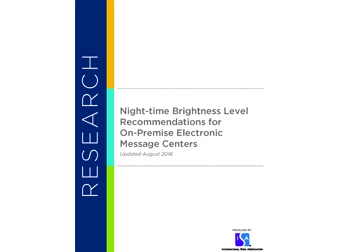The International Sign Association has expanded its popular publication, “Night-time Brightness Level Recommendations for On-Premise Electronic Message Centers.” While the recommended brightness levels remain 0.3 footcandles above ambient lighting, the new publication more detailed information on how to measure brightness levels with and without operational control. It also includes case studies of three communities that have successfully adopted the brightness guidelines.
“This publication has proven to be extremely beneficial to communities across the country,” said David Hickey, ISA vice president of advocacy. “We’re thrilled to be able to republish this document with even more useful information to help local officials develop reasonable sign codes. These recommendations provide a reasonable solution to the hot-button issue of EMC brightness, and they are resulting in more of these kinds of signs being accepted and sold.”
The “Night-time Brightness Level Recommendations for On-Premise Electronic Message Centers” was published based upon the work of noted lighting scientist Dr. Ian Lewin. ISA asked Dr. Lewin to help the industry develop scientifically researched, understandable recommendations for EMC brightness, settling upon the widely adopted 0.3 footcandles.
To date, more than 200 communities have adopted the recommendations in whole or in part; three of them provide case studies in the publication: Columbus, Ohio; Sparks, Nevada; and Kitsap County, Washington. It is available for free download at http://www.signs.org/EMCs.
The publication is just the latest in a growing body of information available about EMCs. In 2012, the Signage Foundation published research from Texas A&M University, which found no link between the addition of an EMC and traffic accidents. It is available at www.thesignagefoundation.org/trafficsafety. The Signage Foundation’s research into the economic impact of illuminated signs—including EMCs—is also available at www.thesignagefoundation.org/library.











